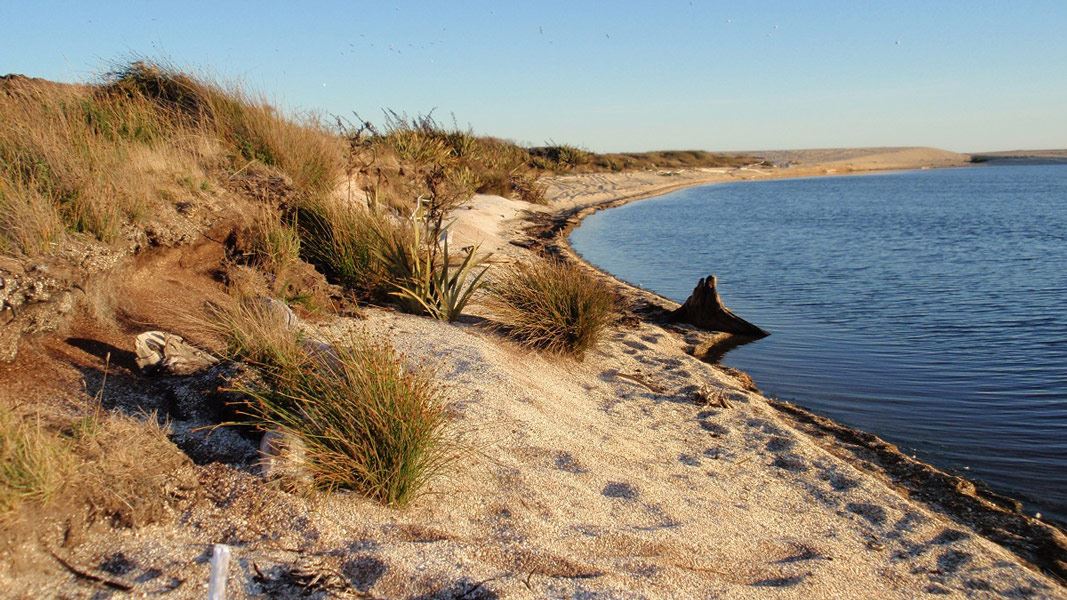
Introduction
Conservation in Awarua-Waituna wetlands is focused on monitoring and protecting the wildlife, protecting waterways, and restoring natural vegetation.Our vision: That the internationally significant lagoon, wetlands, rivers, estuary, forests and heaths are protected through wise stewardship with the community.
Awarua-Waituna is an internationally significant Ramsar site. The coastal wetland system has outstanding biodiversity values and deep cultural significance to Ngāi Tahu.
Conservation efforts in Awarua-Waituna wetlands are focused on monitoring and protecting the rich array of species that live there, protecting waterways and restoring natural vegetation. Land use changes have degraded the wetland ecosystems and water quality, and habitats have suffered as a result. DOC and Fonterra, alongside other agencies, are working together through the Living Water Partnership to reverse this damage and improve the health of the wetlands.
Key projects
Ruppia
Programme objective: Maintain or enhance water regime and water quality
Site target: Ruppia > 30% lagoon cover
Ruppia is a critical aquatic plant species that grows on the bed of the lagoon, limiting erosion and stabilising sediment. It can be used as an indicator of ecosystem health as it both provides habitat for animals and improves water quality.
We monitor ruppia annually as part of our assessment of the lagoon’s health. This helps us decide when it is safer ecologically to have the lagoon open or closed to the sea, as the disturbance caused by opening the lagoon can affect the expansion and stability of aquatic vegetation.
Large scale forest restoration
Programme objective: Protect or restore ecosystem condition
Site target: Restoration of >10 ha of key biodiversity corridors restored to lowland forest
One of our main challenges at Awarua-Waituna is bringing back wetland forest through restoration planting.
Current methods of planting can be time-consuming and costly, so we are undertaking trials of different planting techniques to find less intensive methods that will produce successful results. We aim to find the most efficient way to quickly establish canopy closure and get plantings to a self-sufficient stage.
Fernbird and dotterel protection
Programme objective: Enhance species diversity and protect threatened species
Site target: Increased fernbird and dotterel populations in pest-controlled areas
Fernbirds are threatened by predation and habitat loss through wetland clearance and fire. Dotterels are vulnerable to predation and to human disturbance during breeding season.
We carry out annual monitoring for both populations and are focused on predator control in fernbird and dotterel habitat areas. We are also working to increase wetland visitors’ awareness of dotterel breeding sites and advocating for a fire-free wetland.
Pest animal control
Programme objective: Enhance species diversity and protect threatened species
Site target: Effective pest control on Tiwai Spit and >500 ha of bittern habitat
We aim to control predators of ground-nesting birds, and to minimise browsing impacts on sensitive ecosystems like the coastal turf fields at Tiwai.
Our large network of traps saw a massive 594 pests - mustelids, rodents, feral cats and hedgehogs – caught over the course of a year on Tiwai Peninsula.
Monitoring and management regimes prevent ungulate populations like deer and pig establishing in the wetland. Rabbits and black-backed gulls harm vegetation through browsing and excess nutrients in the gull guano, so we control these species at sensitive plant sites.
Weed control
Programme objective: Protect or restore ecosystem condition
Site target: Effective weed management across 16,000 ha
Spanish heath, gorse and broom are all prolific in the wetland. Spanish heath is a particular problem as it can out-compete manuka after fire disturbance.
We aim to focus on areas where fire has already made land vulnerable to weed infestations, and to prevent man-made fires from doing further damage. We will also control weeds in other areas where fast-growing exotic species are out-competing natives.
Report cards
Brief snapshots of what we’ve achieved so far:
- Awarua-Waituna – giant kōkopu 2017 (PDF, 1,141K)
- Awarua-Waituna – water 2015 (PDF, 2,424K)
- Awarua-Waituna – water 2022 (PDF, 7,302K)
Science publications
- Vegetation status in Waituna Lagoon: 2024 (PDF, 5,500K)
- Technical report on vegetation status in Waituna Lagoon: 2023 (PDF, 3,740K)
- Vegetation status in Waituna Lagoon: 2023 (PDF, 3,484K)
- Vegetation status in Waituna Lagoon: 2021 (PDF, 4,573K)
- Technical report on vegetation status in Waituna Lagoon: 2009–2021 (PDF, 5,118K)
- Vegetation status in Waituna Lagoon: 2019 (PDF, 16,320K)
- Loss of wetlands in Southland on the New Zealand Ecology website
- Aquatic plant dynamics in Waituna Lagoon on the SpringerLink website
- Peatland forest recovery on the University of Canterbury website
- Waituna creek habitat and fish on the Wiley website
Reports on macrophyte monitoring in Waituna Lagoon:
- Summer 2020 (PDF, 10,305K)
- Summer 2019 (PDF, 5,217K)
- Summer 2018 (PDF, 2,268K)
- Summer 2017 (PDF, 643K)
- Summer 2016 (PDF, 737K)
- Summer 2015 (PDF, 629K)
- Summer 2014 (PDF, 708K)
See all our publications in the Arawai Kākāriki science bibliography.
Key partners
Working in partnership with organisations and communities to share knowledge is an intrinsic element of Arawai Kākāriki.
Key partners involved with Awarua-Waituna:
- Living Water (DOC-Fonterra partnership)
- Te Ao Marama
- Te Rūnanga o Ngāi Tahu
- Environment Southland
- Fish & Game
- Nature Heritage Fund
- Waituna Landcare Group
- Local farmers and landowners
- Local schools
- Thousands of individuals from Southland
Contact
DOC Customer Service Centre
| Phone: | 0800 275 362 |
| Email: | invercargill@doc.govt.nz |
| Address: | Murihiku / Invercargill Office |